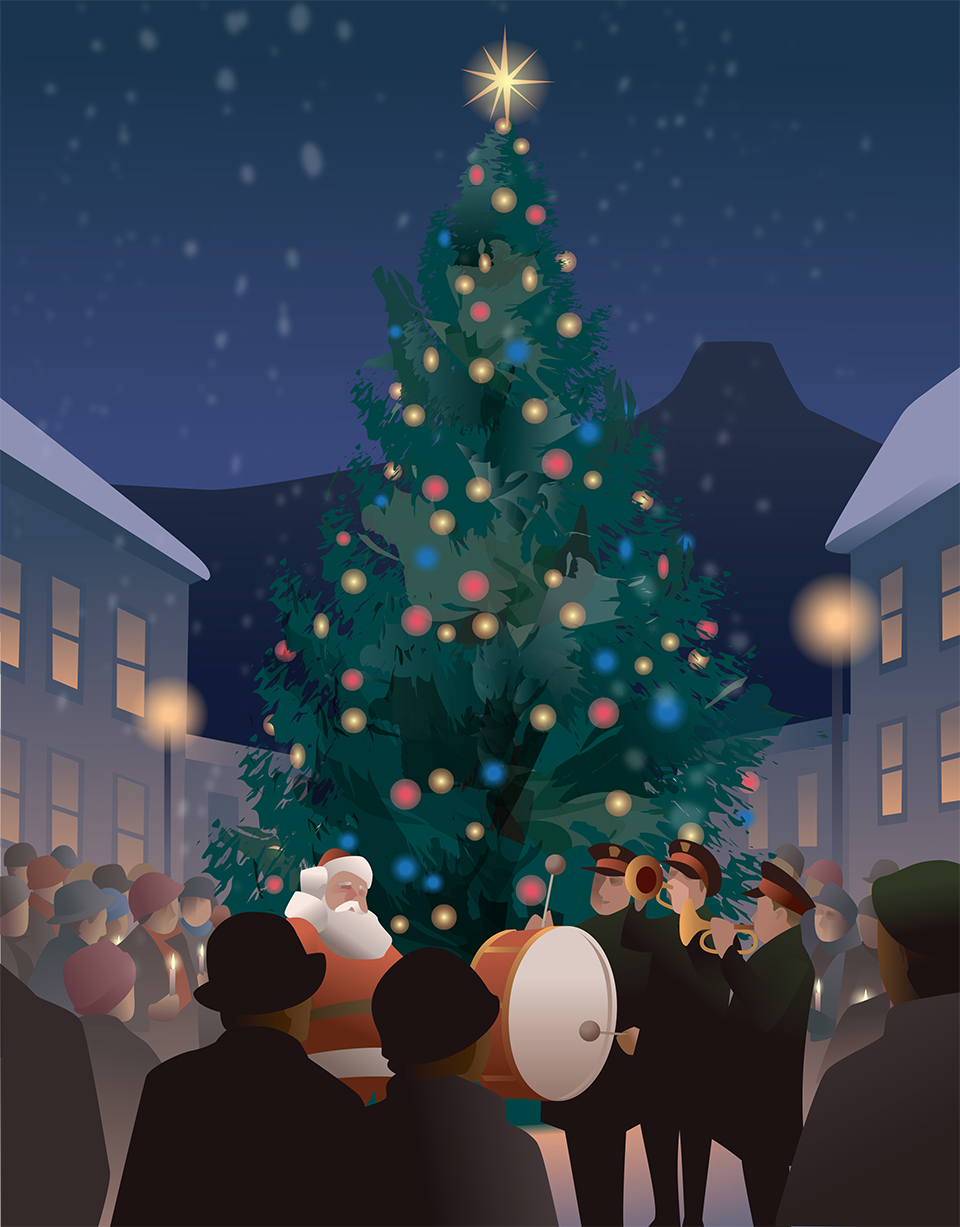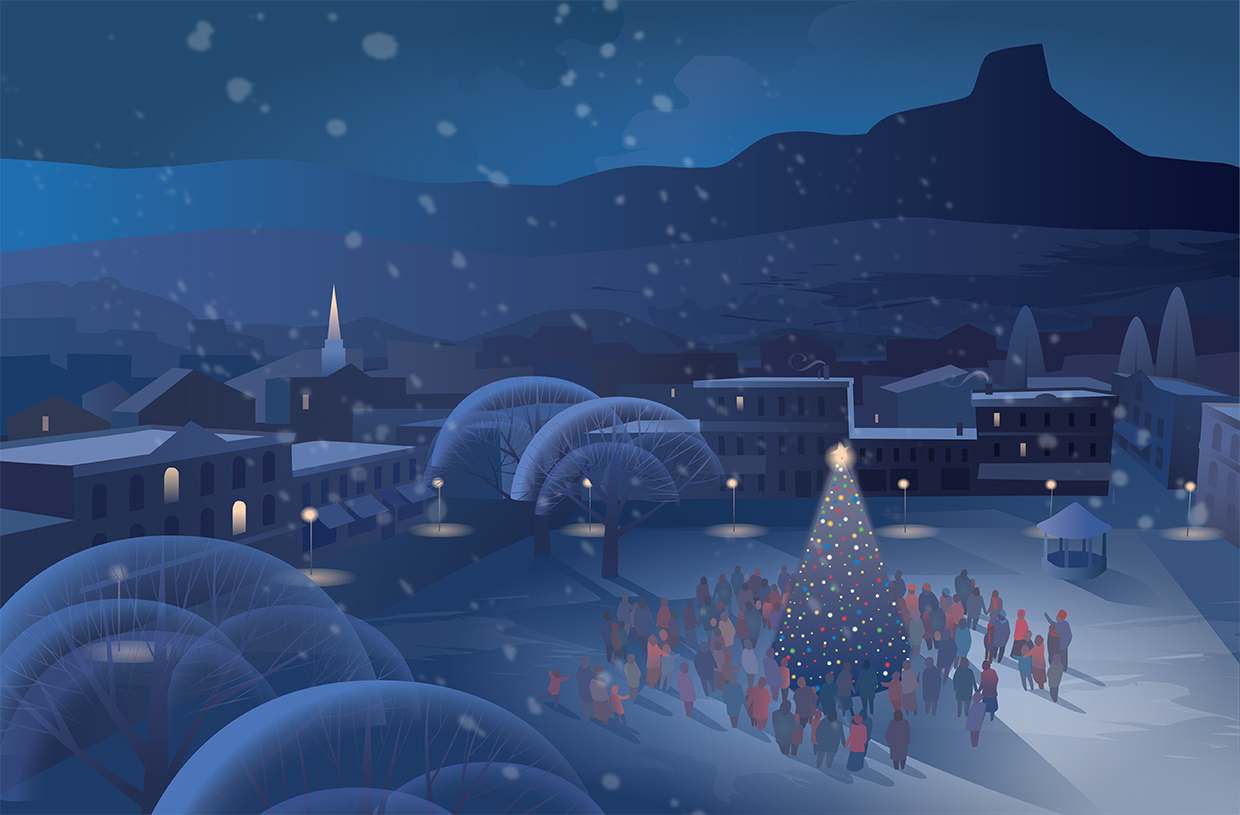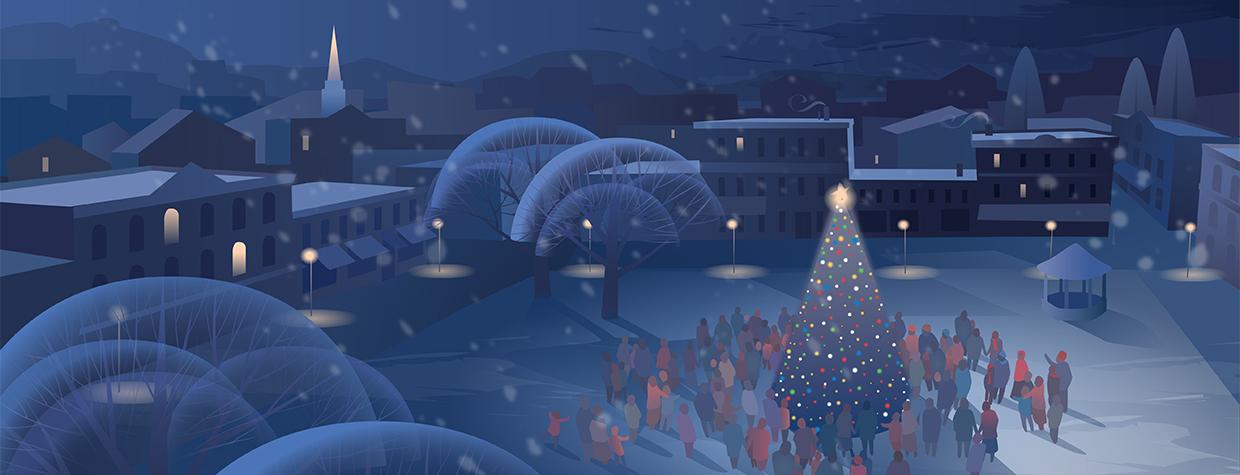1916 was shaping up to be a good year in Prescott. In October, residents saw the cornerstone laid for the new Yavapai County Courthouse. And as the year drew to a close, it seemed the Christmas star would shine a little brighter on the town.
“Many Hearts to Be Gladdened,” a Christmas Eve headline proclaimed. “Lighted in a myriad of incandescent lights, the first municipal Christmas tree ever held in the state of Arizona will blaze forth its message of ‘peace and good will to all’ on the plaza,” the story read. What’s more, no family would do without.
The 30-foot tree would be laden with gifts to be distributed to families in need: “dolls for the little girls; tops, marbles and coaster-wagons for the boys.” For their parents, “warm shoes and wraps.” “Meats and other household necessities” would accompany these gifts, “so that their Christmas tables will be set with all of the delicacies that make a joyous Christmas.”
With snow blanketing the plaza, as many as 100 residents gathered that night to hear the combined choirs of Prescott’s churches sing Silent Night. Certainly, none among them could have imagined that this last-minute event would become a tradition as enduring as the granite courthouse, eventually growing into the modern extravaganza that earned Prescott the title of “Arizona’s Christmas City” — and last year led Newsweek readers to vote Prescott among the “Best Christmas Towns.”

While 1916 marked an important milestone, Christmas had been celebrated in Prescott since its earliest days as Arizona’s Territorial capital. Bishop Jean Baptiste Lamy recorded the first known Christmas in Prescott the year President Abraham Lincoln signed the bill creating the Territory. The Territorial government was still working its way to the new capital in December 1863, when Lamy stopped along Granite Creek on his way to San Francisco. Staying in a miner’s cabin built from packing crates, he celebrated Mass for two dozen miners. The small congregation knelt on snow-covered ground before a makeshift altar of tree trunks, in temperatures so cold the chalice had to be thawed near the fire several times.
Conditions had improved by the next year, when the governor served a Christmas feast in the new Governor’s Mansion. But a Christmas tree did not appear until 1865, when Margaret McCormick, wife of acting Governor Richard McCormick, invited everyone in the community to the mansion to celebrate the season. Prescott women made gifts: scarves for the boys, handbags filled with little cakes for the girls.
Having interviewed pioneers who attended, poet and historian Sharlot Hall later wrote, “This tree was celebrated on Christmas Eve. On Christmas night there was a big dance. … There had been rag dolls made for all the little girls and put on the tree the night before, and one woman told me how, as a child, she took her doll to the dance the next evening and danced with the grown men while hanging tightly onto her wonderful doll with one hand. There were so few women that the little girls were needed to make up the sets in the dances.”
The plaza and courthouse also saw their share of holiday merriment, including some good-natured pranks. In the 1860s, Prescott pioneers hung old boots, overalls and coats stuffed with pints of whiskey on trees in the plaza, attaching tags with the intended recipients’ names. “Among the trees on the plaza was a shaggy juniper on the east side whose branches attracted the notice of jokers who had a mind to play Christmas tricks on each other,” an undated news article recounted. “For years gifts, all the way from broad jokes to real needs, were hung on this tree. ... Some of the jokes had a bit of sting in them — and at last the axe of one of the stung was laid to the roots of the innocent tree.”
The first event held in an earlier courthouse, on North Cortez Street, was not a trial but a holiday gathering. That celebration included a Christmas tree covered with gifts for children and adults — “everything imaginable that was obtainable in Prescott.” And in 1874, hundreds attended a celebration in the courtroom, with a row of Christmas trees and Santa arriving to hand out gifts to the children. But most of the Christmas celebrations in those days took place in churches, theaters, schools and saloons.

As far as anyone knew, by 1916, there had never been an outdoor municipal tree lighting anywhere in the state. Someone at the Prescott Chamber of Commerce got the idea to hold one on the courthouse plaza. It was just a week before Christmas when chamber members met with local ministers and city officials to discuss the idea for the first time.
“While every question was brought to bear as to why it should or should not be held, the opinion was unanimous in favor of the big tree,” the Prescott Journal Miner reported. “Everyone is to have a share in this tree, and for that reason, it will be termed the municipal tree.
“That the poor may be taken care of to the very best advantage, a list will be compiled by the ministers and the school teachers and compared with that of the Associated Charities, so that each and every needy person will be taken care of by those who desire to make of themselves ‘good fellows.’ ”
A committee formed to canvass the city and solicit donations; within a few hours, it had collected $125, consisting of individual contributions ranging from 15 cents to $25. In the next few days, donations quickly overshot the graphic that a Boy Scout leader had painted to track the fundraising.
“The Scout executive admits that he greatly underestimated the generosity of the people of Prescott when he determined upon the scale for the graphic,” the Journal Miner reported. First setting it at $250, the Scout leader quickly raised it to $350. “When last interviewed, he predicted that the tree would ‘push the roof off’ during the night,” the paper reported. And it did, with donations eventually reaching $400 — the equivalent of about $12,000 today.
Meanwhile, merchants donated toys and gifts, “the largest assortment coming from Mrs. J.A. Hope of the Bashford-Burmister Company,” the newspaper reported. “This assortment showed everything from a baby doll to an aeroplane.” Only the chairman of the committee in each district knew the destinations of the gifts, which the Boy Scouts would deliver discreetly to preserve the dignity of the recipients.
In the midst of all that activity, the city clerk arranged for “one of the largest and most stately of Yavapai’s spruces” to be cut and placed near the bandstand on the plaza. The Arizona Power Co. would decorate it with more than 100 colored lights to ensure the first municipal Christmas tree would be “a scene of beauty never to be forgotten.”
By 10 p.m. on December 23, everything was ready. And amid a winter storm that left a foot of snow on the higher elevations, the Christmas Eve program was “short and snappy.”
“Mingled with the soft patter of falling snow and the murmur of the wind through the trees, glad voices were lifted upon the air and carried straight to the hearts of the 75 or 100 people who attended the exercises,” the Journal Miner reported.
“While the entertainment was going on, the Boy Scouts … were carrying load after load and basket after basket to the homes of the poor and worthy in Prescott. No one was too old or too young to be forgotten. Food, clothing and toys were distributed from one side of the town to the other.
“It was almost midnight before the last basket left the Boy Scout headquarters. … And if there is one worthy soul in Prescott today which was not made happier for the arrival of Christmas, then he or she is hard to please.”

The event was so successful that the newspaper predicted the municipal Christmas tree would be repeated the following year. And it was. Despite food rationing and a sugar shortage caused by World War I, 500 people, including Santa himself, gathered on the plaza for the municipal tree lighting in 1917. And the tradition endured for decades. Lester “Budge” Ruffner — known to longtime Arizona Highways readers for his Bookshelf column — recalled gathering with his friends to watch the tree go up in the 1920s and through the Great Depression.
Ruffner recalled that the Salvation Army band, consisting of a couple of coronets and a bass drum, provided the music. During the Depression, Santa gave each child a red net bag with an apple, an orange and some hard candy.
The first tree lighting Linda Chase remembered was the year the Japanese bombed Pearl Harbor. “Somehow, we were taught both verses of Santa Claus Is Comin’ to Town so that we could sing them from the steps of the courthouse,” she wrote years later. “I think the song was new then, and I remember hearing White Christmas for the first time that year or the next.
“A very tall tree on the north side of the plaza held the lights that constituted Prescott’s ‘lighting,’ and I don’t know if it was cut and brought in from the Bradshaw Mountains or grew right where I was seeing it on that special night. It glowed with more colored lights than I had ever seen anywhere, and I was enchanted. … I don’t believe that Prescott had a community Christmas tree again until after the war was over.”
In the mid-1950s, the event took a big step forward when the Chamber of Commerce Decorations Committee, with help from other civic groups, began creating Christmas scenes around the plaza, as well as decorating the courthouse itself. Santa kept up with the times, too, arriving in a firetruck or helicopter over the years.
Thousands now crowd the plaza to watch as a million lights illuminate some 80 trees and fireworks light up the sky. And these days, the holiday spirit spills over to embrace the entire city. In the 1990s, Sharlot Hall Museum debuted its Frontier Christmas event, with costumed interpreters re-enacting the 1865 Christmas at the Governor’s Mansion. In the same decade, the downtown light parade debuted, with a bonfire added some years later.
Other festivities include Prescott Resort’s Gingerbread Village, billed as one of the world’s largest; the Valley of Lights, at Fain Park in Prescott Valley; and the citywide Acker Night music festival. More recently, a German-themed Christmas Village and Christkindl Market has featured German-style food and music, a beer garden and horse-drawn-carriage rides around the plaza. All of it, of course, requires months of planning and fundraising.
Certainly, visions of future sugarplums danced in the heads of Arizona’s first municipal tree lighting organizers, but they could hardly have imagined all that would grow over more than a century from their small, hastily planted seed.

